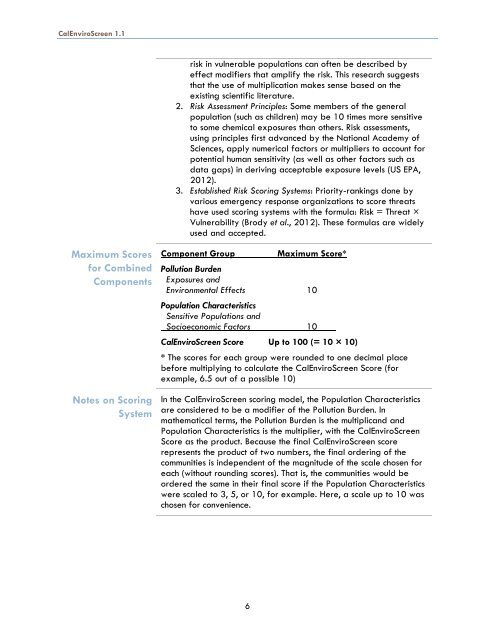CalEnviroscreen Version 1.1 - OEHHA - State of California
CalEnviroscreen Version 1.1 - OEHHA - State of California
CalEnviroscreen Version 1.1 - OEHHA - State of California
You also want an ePaper? Increase the reach of your titles
YUMPU automatically turns print PDFs into web optimized ePapers that Google loves.
CalEnviroScreen <strong>1.1</strong><br />
risk in vulnerable populations can <strong>of</strong>ten be described by<br />
effect modifiers that amplify the risk. This research suggests<br />
that the use <strong>of</strong> multiplication makes sense based on the<br />
existing scientific literature.<br />
2. Risk Assessment Principles: Some members <strong>of</strong> the general<br />
population (such as children) may be 10 times more sensitive<br />
to some chemical exposures than others. Risk assessments,<br />
using principles first advanced by the National Academy <strong>of</strong><br />
Sciences, apply numerical factors or multipliers to account for<br />
potential human sensitivity (as well as other factors such as<br />
data gaps) in deriving acceptable exposure levels (US EPA,<br />
2012).<br />
3. Established Risk Scoring Systems: Priority-rankings done by<br />
various emergency response organizations to score threats<br />
have used scoring systems with the formula: Risk = Threat ×<br />
Vulnerability (Brody et al., 2012). These formulas are widely<br />
used and accepted.<br />
Maximum Scores<br />
for Combined<br />
Components<br />
Notes on Scoring<br />
System<br />
Component Group<br />
Maximum Score*<br />
Pollution Burden<br />
Exposures and<br />
Environmental Effects 10<br />
Population Characteristics<br />
Sensitive Populations and<br />
Socioeconomic Factors 10<br />
CalEnviroScreen Score Up to 100 (= 10 × 10)<br />
* The scores for each group were rounded to one decimal place<br />
before multiplying to calculate the CalEnviroScreen Score (for<br />
example, 6.5 out <strong>of</strong> a possible 10)<br />
In the CalEnviroScreen scoring model, the Population Characteristics<br />
are considered to be a modifier <strong>of</strong> the Pollution Burden. In<br />
mathematical terms, the Pollution Burden is the multiplicand and<br />
Population Characteristics is the multiplier, with the CalEnviroScreen<br />
Score as the product. Because the final CalEnviroScreen score<br />
represents the product <strong>of</strong> two numbers, the final ordering <strong>of</strong> the<br />
communities is independent <strong>of</strong> the magnitude <strong>of</strong> the scale chosen for<br />
each (without rounding scores). That is, the communities would be<br />
ordered the same in their final score if the Population Characteristics<br />
were scaled to 3, 5, or 10, for example. Here, a scale up to 10 was<br />
chosen for convenience.<br />
6















